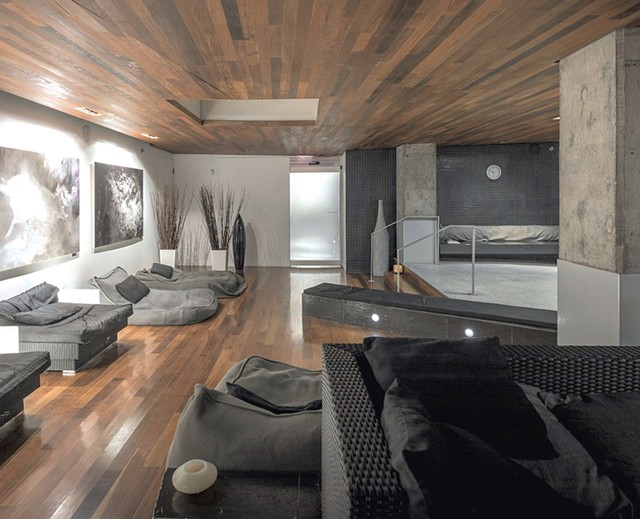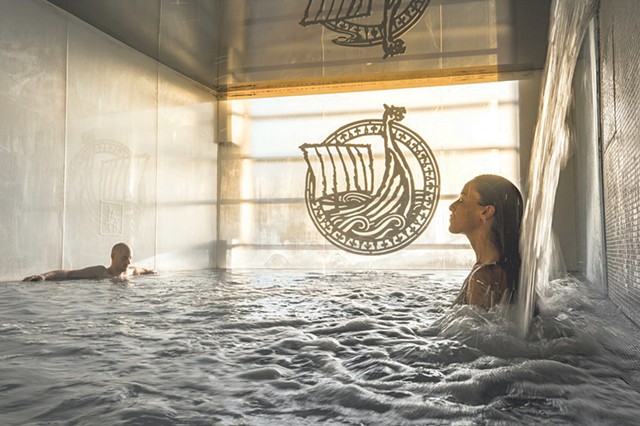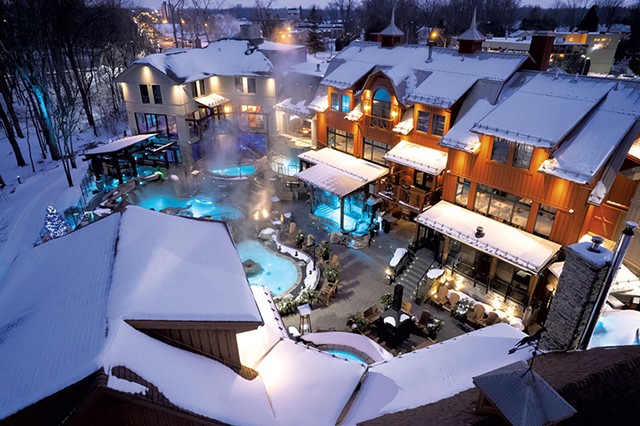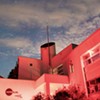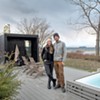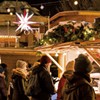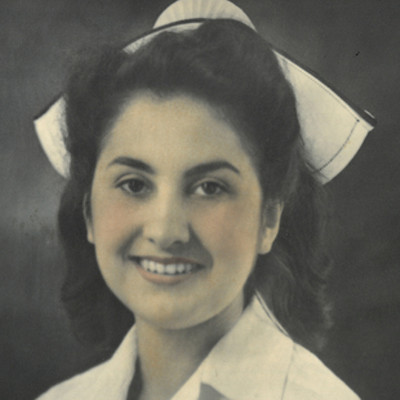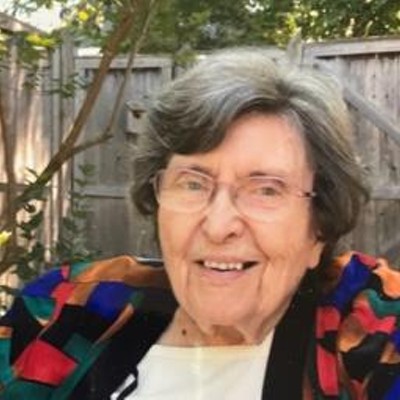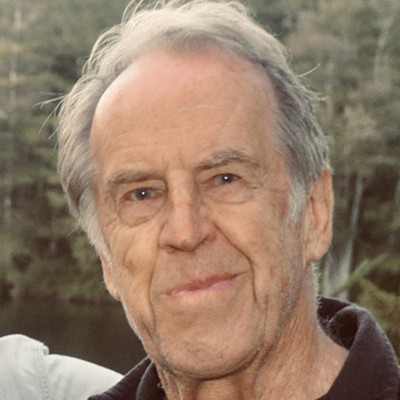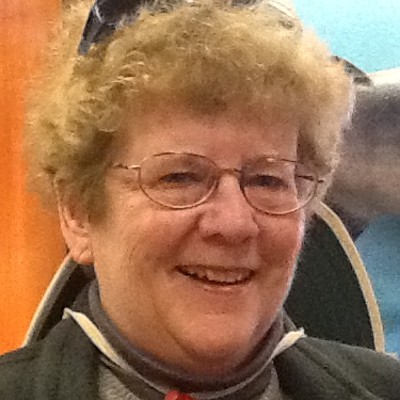Switch to the mobile version of this page.
Vermont's Independent Voice
- News
- Arts+Culture
- Home+Design
- Food
- Cannabis
- Music
- On Screen
- Events
- Jobs
- Obituaries
- Classifieds
- Personals
Browse News
Departments
Browse Arts + Culture
View All
local resources
Browse Food + Drink
View All
Browse Cannabis
View All
-
Culture

'Cannasations' Podcaster Kris Brown Aims to 'Humanize'…
-
True 802

A Burlington Cannabis Shop Plans to Host…
-
Business

Judge Tosses Burlington Cannabiz Owner's Lawsuit
-
Health + Fitness

Vermont's Cannabis Nurse Hotline Answers Health Questions…
-
Business

Waterbury Couple Buy Rare Vermont Cannabis License
Browse Music
View All
Browse On Screen
Browse Events
Browse Classifieds
Browse Personals
-

If you're looking for "I Spys," dating or LTRs, this is your scene.
View Profiles
Special Reports
Pubs+More
Montréal's Hydrothermal Spas Dole Out Hot and Humid Relaxation
Published January 18, 2023 at 10:00 a.m. | Updated February 7, 2023 at 2:58 p.m.
click to enlarge 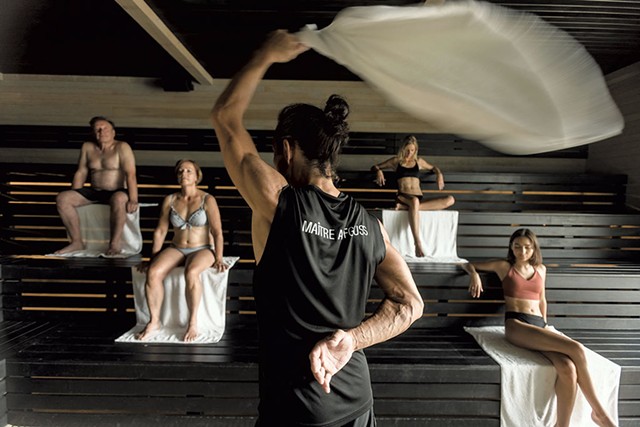

- Courtesy Of Förena Cité Thermale
- An aufgussmeister executing a German towel ritual in a sauna at Förena Cité Thermale
Standing in a sweltering sauna near Montréal on a recent morning, Dominique Evens whirled a towel through the air, snapping the terry cloth to the piped-in sounds of sitar jazz.
Evens, a Montréaler who has a black goatee and an easy smile, was guiding an aufguss session at Förena Cité Thermale, a sprawling spa complex that opened in early 2020 in the city's suburb of Saint-Bruno-de-Montarville. Aufguss is a ritual originating in Germany that enlivens the usual sit-and-sweat sauna experience with an artful combination of music, air movement, lights and scent.
"The aufgussmeister is the master of the sauna, so he will decide how to distract you for 15 minutes in the sauna," said Evens, who learned the basics by immersing himself in aufguss videos on YouTube. He executes the practice with more flair than the words "German towel ritual" might suggest. Each session is designed to help spa visitors withstand a brief period of extra-hot sauna conditions, he explained, to maximize the potential health benefits.
Förena is the most recent addition to Montréal's already impressive collection of hydrothermal spas, often called Nordic spas for their links to that region's bathing traditions. All combine heating and cooling elements, such as saunas, steam rooms and cold plunges, laid out in a prescribed "thermal cycle." Hot, cold, relax: Research points to resulting benefits for mental health, cardiovascular function and pain management.
A 21st-century Canadian passion for hydrothermal bathing began in Québec and remains most vibrant there, but the past several years have seen the spas proliferate from British Columbia to Newfoundland.
"Canada, as a country, tends to be less resistant to European influences than the United States," said Don Genders, head of the Hydrothermal Initiative at the Global Wellness Institute, by way of explaining Canada's comparatively early adoption.
Luckily, Montréal's spas are only a day trip away. And now, the hydrothermal vogue is finally making its way across the international border. Vermont-based Savu — the name means "smoke" in Finnish — has private saunas available hourly near Smugglers' Notch and the Burlington waterfront. Genders' company, Design for Leisure, is consulting with Urban Moonshine founder Jovial King, whose Nordic-inspired Silt Botanica bathhouse is scheduled to open on Burlington's Pine Street in spring 2025.
Aficionados argue that these traditional bathing establishments are a grounded alternative to the facials and fanciness of American spas. In places such as Finland, Norway and Sweden, regular trips to the sauna are seen as part of routine wellness. Visiting is a chance to relax and catch up on gossip.
"It's going to take some time for us to kind of shift culturally that much, but I think we have a really ripe moment to do so," King said. "People are reaching for self-care. They're reaching for immersive experiences."
From thermal pools to saunas, the traditions that spas draw upon are both widespread and ancient.
"Sweat bathing is common throughout the globe — like fermenting of the grape or baking bread, it's just one of those things we have found in most cultures," said Mikkel Aaland, the Norwegian American author of Sweat, a now-classic 1978 book on bathing culture.
While interest in traditional bathing has wavered in the face of modernity and modern plumbing, it is returning. When Aaland researched the book in the 1970s on trips to Turkey, Mexico and Scandinavia, he often discovered that the practice had become less common. On more recent travels for his upcoming documentary series "Perfect Sweat," in which he revisited some of the same destinations, Aaland found sweat-bathing traditions resurgent. It's a relaxation revival. Or, as Aaland prefers, a remembering.
"I like that word, remembering, because this is nothing new for some of these cultures," he said. "The foundation is there. The basics of their forms of sweat baths have been there for thousands of years."
Those foundations include the Islamic hammam, steamy public baths that drew inspiration from earlier Roman thermae. Māori people of Aotearoa-New Zealand have long used geothermal baths for medicinal purposes. And in ancient Mexico and Central America, steamy temazcal saunas were prized for health, spiritual renewal and hygiene.
But it is in Nordic countries, particularly Finland, that sauna bathing has remained central to modern life, and that influence predominates at Montréal's hydrothermal spas.
With a Viking ship for its logo, Scandinave Spa Vieux-Montréal offers urban relaxation in a hushed facility a few blocks from the historic waterfront. Housed in a converted ferry bobbing in the St. Lawrence River, Bota Bota Spa-Sur-L'eau might not call itself Nordic, but its modern design and pale woods riff unmistakably on Scandi-chic.
On Montréal's riverine Nuns' Island, Strøm Spa Nordique feels like a portal into some boreal woodland. It has a Finnish barrel sauna, a hygge relaxation room and a cold Nordic bath with a sign reading "restez calme." Presumably this is because a natural reaction to going from sauna to 60-degree water is not, in fact, to stay calm, but to wave one's arms and shriek — embarrassing, given the overall aesthetic of design-forward minimalism.
Not all hydrothermal spas are quite so ascetic, or so focused on Nordic traditions. In Montréal's northerly suburb of Rosemère, Spa Le Finlandais brings a more playful spirit. Visiting in early January, I joined a wine-drinking crowd, many dressed in Canadiens hats and colorful BYO bathrobes. There were stations to rub yourself with salt and stations to rub yourself with snow. Chatting groups drifted between the elaborate Turkish bath, the Japanese sauna and the orb-like "Helsinki bubbles" floating in an outdoor hot pool. Chartreuse light illuminated craggy rocks with theme park vibes.
Förena also has global ambitions, if more muted décor. Evens, the aufgussmeister, told me of coming expansions based on Middle Eastern and Asian traditions, adding to the spa's current German, Icelandic and Russian offerings. But such distinctions blur amid steam and heat. The German-inspired aufguss session I attended was held in the spa's Russian banya.
Evens made the space his own. He moved to a very un-Slavic soundtrack of hip-hop and jazz while directing puffs of hot air at each of us in turn. He dashed sage-scented water onto hot stones to drive the temperature higher. Several red-faced participants slid down to the slightly cooler bottom benches. An hourglass on the wall marked time. Evens handed out tiny cups of sunny-tasting guava juice to sustain us.
And then our time ran out. Evens guided us, a row of sweaty ducklings, toward a nearby ice-cold plunge bath. When it came to reaping the full benefits of aufguss, he admonished, cooling off was critical.
"Allez-y, allez-y!" Evens cried, leading the way into the pool. "In the water! You can do it!"
Förena Cité Thermale
Relaxation and activities, with no Montréal city driving required
click to enlarge 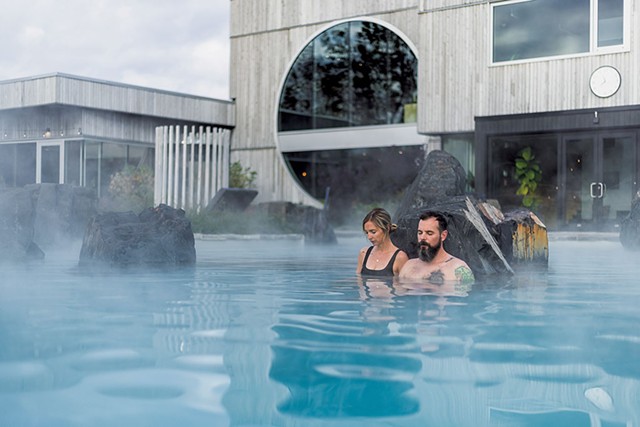

- Courtesy Of Förena Cité Thermale
- A hot pool inspired by Iceland's volcanic landscape at Förena Cité Thermale
Blue-tinged hot pools steam outside of Förena Cité Thermale, studded with craggy black boulders inspired by Iceland's volcanic landscape, while saunas nod to German and Russian bathing traditions. What sets this Saint-Bruno spa apart, however, are the activities included in the price of entry.
Daily schedules suggest a spa-themed adult summer camp. A visitor might follow an aufguss session with a 30-minute yoga class and an ASMR sensory meditation at the German sauna, then return to the banya for some gentle, guided stretching.
Quiet talking is allowed in most areas, but others, including a dorm-like relaxation room and a wood-heated geodesic dome overlooking nearby fields, are silent.
And if the idea of "spa food" evokes minuscule plates of macrobiotic veggies, think again. The on-site restaurant is more indulgent than abstemious, with an impressive wine list and specialties, such as German sausage and brioche-like Russian vatrushka, from the regions whose bathing traditions are represented here.
250 Rang des Vingt-Cinq Est, Saint-Bruno-de-Montarville; forena.ca; Can$80 for full-day passes; ages 16 and up
Scandinave Spa Vieux-Montréal
Steamy calm in the heart of Old Montréal
Down the street from Montréal's historic Notre-Dame Basilica, Scandinave Spa is an enclave amid the Old Port's clattering cobblestones and tourist shops. Hot elements include a eucalyptus steam bath, a Finnish dry sauna, a hot bath and a thermal waterfall; the plunge pool and showers are a bracing cooldown.
This is perhaps the quietest Montréal spa, and most guests adhere to the strict silence policy. Screens including e-readers are banned, so bring a book to enjoy in the relaxation area filled with heated slate benches, giant cushions, daybeds and cocoon-like hanging chairs.
Unlike many other Montréal Nordic spas, this is an indoor-only location with a compact footprint, and most visitors will be content to leave after a couple of hours. But if you're exploring the city on a frigid winter day — gliding around, perhaps, on the nearby Old Port ice skating rink — Scandinave Spa is a blissful way to get warm.
Scandinave has additional locations in Whistler, Mont-Tremblant and Blue Mountain, and it teams up with neighboring hotel Le St. Sulpice to offer overnight deals.
71 rue de la Commune Ouest, Montréal; scandinave.com/vieux-montreal; prices vary by time, day and season, ranging from Can$77 to $95 for all-day access and $60 to $80 for walk-ins; ages 16 and 17 are allowed when accompanied by an adult
Bota Bota Spa-sur-l'Eau
Modernist spa-chic in a converted ferry boat
click to enlarge 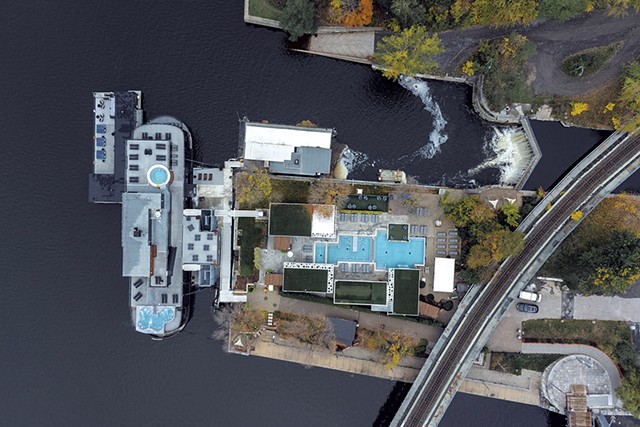

- Courtesy Of Thibault Carron
- Bota Bota Spa-Sur-L'Eau, housed in a converted ferry on the St. Lawrence River
Bobbing gently just off the Old Port of Montréal, this beloved floating spa is walking distance from the city's downtown and historic center. The Japanese name is a watery onomatopoeia meaning "drip-drip."
A geometric, matte-black exterior signals the spa's contemporary style, including saunas whose floor-to-ceiling glass walls open to the city skyline and nearby architectural landmark Habitat 67. Winter months lend the view some extra drama by turning the surrounding harbor to ice — the luckiest visitors might even spot an ice canoe team racing past.
Silence is required on board, where offerings include saunas, a steam bath, hot tubs, a cold plunge and spaces to relax. Quiet conversation is permitted in the adjacent garden, which has a hot-and-cold water circuit of its own.
Book in advance to dine at the onboard restaurant La Traversée, whose Provençal chef, Thomas Engasser, serves refined meals using ingredients sourced from Québécois farms. Despite caps on visitors, the busiest days at this popular spa can feel overcrowded, making this an especially worthwhile destination during the quieter midweek.
Located on the waterfront between rue McGill and rue de la Commune Ouest, Montréal; botabota.ca; prices vary with time, day and season, ranging from Can$60 to $85 for two- or three-hour visits; adults only, although youths 12 to 17 are welcomed for occasional special events
Strøm Spa Nordique Nuns' Island
Woodsy tranquility minutes from downtown
click to enlarge 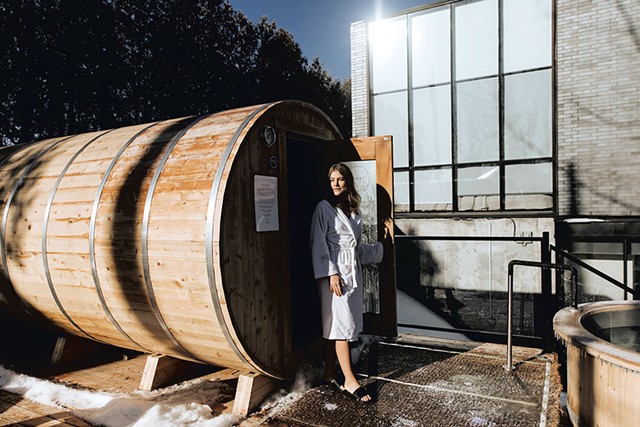

- Courtesy Ofstrøm Spa Nordique Nuns' Island
- A barrel sauna at Strøm Spa Nordique Nuns' Island
Strøm Spa Nordique, which also has locations in Québec City, Sherbrook and Mont-Saint-Hilaire, channels Nordic bathing and style: clean lines, muted colors, plenty of steam.
Picture windows in the saunas frame a startlingly sylvan view. Though wrapped in residential streets, the Nuns' Island facility looks onto deciduous forest and the man-made Lac des Battures, a favored hangout for migratory birds including least bitterns and peregrine falcons.
Hot waterfalls tumble into the outdoor baths, and the saunas come in dry, aromatic, steamy and barrel varieties. Between outdoor fireplaces and relaxation yurts, this is a silent spa that invites all-day lounging sustained by a stop at the on-site restaurant, Nord. (You can talk at the restaurant.) Its Nordic-inspired cuisine ranges from trout gravlax to open-face mushroom smørrebrød sandwiches to the leek-rich fish soup known as fiskesuppe.
1001 boulevard de la Forêt, Verdun; stromspa.com; Can$59 to $79 for reserved spa access; $44 for walk-ins outside of high season, but there's often a waiting list; ages 16 and up
Spa Le Finlandais
Cheerful global-bathing kitsch and a convivial atmosphere
click to enlarge 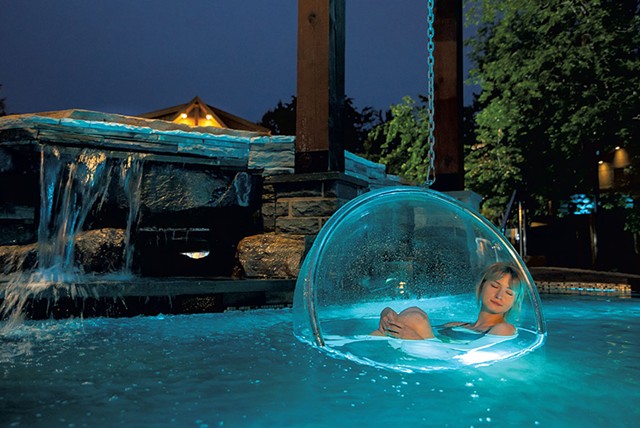

- Courtesy Ofspa Le Finlandais
- "Helsinki bubbles" floating in an outdoor hot pool at Spa Le Finlandais
Posters in this sprawling spa complex invite visitors to enjoy their apéros en maillot de bain — cocktail hour in a bathing suit — signaling the spirit that prevails here. Forget Scandi minimalism: This is more about hot tub mingling over plastic stem glasses of chardonnay.
While the name hat-tips Finland, the spa is like a bathing-themed model United Nations located midstream in the Thousand Islands river. A visitor might start in the Maya temazcal or the Japanese sauna, then take a frigid Nordic shower in preparation for a steamy session in the Islamic hammam.
click to enlarge 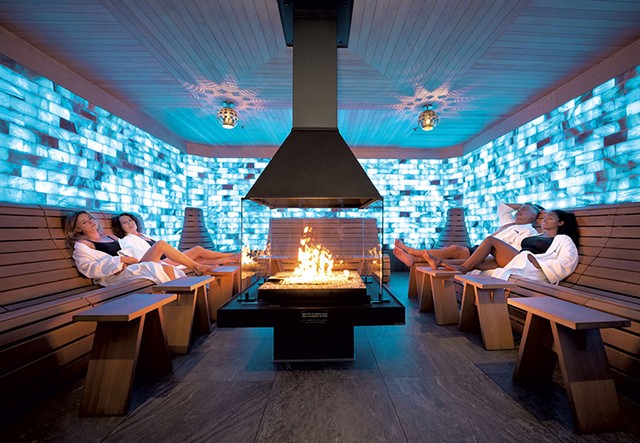

- Courtesy Ofspa Le Finlandais
- Spa Le Finlandais' Himalayan Lounge, with walls made of color-changing blocks of pink Himalayan salt
That hammam is within the 1001 Nights Pavilion, which also includes a Moroccan lounge, a Turkish bath, an exfoliation room and an Egyptian sauna. Arabesques abound. Edward Said comes to mind, but only briefly, because the next stop is a giant barrel sauna emblazoned with runic writing and a Viking ship.
The overall effect is deliciously unserious fun. An on-site hotel means you can soak until tender as overnight brisket and ooze straight to bed, then return for a morning session before checkout time.
124-125 boulevard Labelle, Rosemère; spalefinlandais.com; Can$100 to $120 for full-day spa access; $50 to $60 for half-day access; $10 towel and robe rental, so many guests BYO; hotel rooms start at $159, including breakfast; $65 for spa access with hotel booking; ages 16 and up
Nordic Know-How
Plan it out. Spas close to walk-ins when they reach capacity, so it's worth booking in advance, especially when visiting at popular times. (A few only accept bookings until 48 hours before your visit.) Weekdays are less crowded and generally cheaper — some spas offer weekday deals on treatments such as massage, as well.
Take a toque. Frigid weather nips exposed skin even if you're neck-deep in a hot tub, so savvy Québécois spa-goers bring a winter hat to wear outdoors on the coldest days. You'll want to pack sandals, plus a bathing suit to wear in the saunas and pools, since suits are required for all spa-goers.
Don't lose the robe. Spas that offer robes charge for replacements. Hold on to your spa-provided robe as you move between thermal stations, and try not to saturate it. Nothing dampens a post-spa relaxation session like wrapping up in sodden terry cloth.
Drink up. Steer clear of booze, though, because alcohol and saunas don't play well together. To replace all the sweat you're losing, experts recommend drinking two to four glasses of water after each sauna session. Some suggest rehydrating with fluids that contain sodium and simple sugars, such as a sports drink.
The original print version of this article was headlined "Steam Scene | Montréal's hydrothermal spas dole out hot and humid relaxation"
Related Stories
Got something to say?
Send a letter to the editor
and we'll publish your feedback in print!
Tags: Health + Fitness, Wellness Issue, Montréal, hydrothermal spa, Förena Cité Thermale, Scandinave Spa Vieux-Montréal, Bota Bota Spa-sur-l'Eau, Strøm Spa Nordique Nuns' Island, Spa Le Finlandais
More By This Author
About The Author
Jen Rose Smith
Bio:
Jen Rose Smith is a writer in Richmond. Her work has been published by the Washington Post, National Geographic, the BBC and CNN. She is the author of six travel guidebooks to Vermont and New England, including the award-winning New England Road Trip.
Jen Rose Smith is a writer in Richmond. Her work has been published by the Washington Post, National Geographic, the BBC and CNN. She is the author of six travel guidebooks to Vermont and New England, including the award-winning New England Road Trip.
Speaking of...
-

Montréal's Jewish Eateries Serve Classics From Around the World
Apr 9, 2024 -

Soundbites: Surf's Up With TEKE::TEKE
Mar 27, 2024 -

Where to See the 2024 Solar Eclipse in Québec
Feb 26, 2024 -

Montréal’s McCord Stewart Museum Features a Groundbreaking Exhibit of Indigenous Art
Feb 7, 2024 -

How to Protect Your Vision While Viewing the Eclipse
Jan 17, 2024 - More »
Comments
Comments are closed.
From 2014-2020, Seven Days allowed readers to comment on all stories posted on our website. While we've appreciated the suggestions and insights, right now Seven Days is prioritizing our core mission — producing high-quality, responsible local journalism — over moderating online debates between readers.
To criticize, correct or praise our reporting, please send us a letter to the editor or send us a tip. We’ll check it out and report the results.
Online comments may return when we have better tech tools for managing them. Thanks for reading.
- 1. The Magnificent 7: Must See, Must Do, May 1-7 Magnificent 7
- 2. Student Film Documents Failed Plan to Cut Books From Vermont State University Libraries Film
- 3. A Former MMA Fighter Runs a Wildlife Rehabilitation Center in Cabot News
- 4. This Manchester Center Family Is a National Show Horse Powerhouse Animals
- 5. Animal Communicator Amy Wild Wants a Word With Your Pet Animals
- 6. Ever Since the Solar Eclipse, I’ve Been Feeling Weird Ask the Rev.
- 7. Welch Pledges Support for Nonprofit Theaters Performing Arts
- 1. How a Vergennes Boatbuilder Is Saving an Endangered Tradition — and Got a Credit in the New 'Shōgun' Culture
- 2. Video: The Champlain Valley Quilt Guild Prepares for Its Biennial Quilt Show Stuck in Vermont
- 3. Waitsfield’s Shaina Taub Arrives on Broadway, Starring in Her Own Musical, ‘Suffs’ Theater
- 4. Video: 'Stuck in Vermont' During the Eclipse Stuck in Vermont
- 5. Pet Project: Introducing the Winners of the 2024 Best of the Beasts Pet Photo Contest Animals
- 6. This Manchester Center Family Is a National Show Horse Powerhouse Animals
- 7. Crossing Paths: An Eclipse Crossword 2024 Solar Eclipse





























